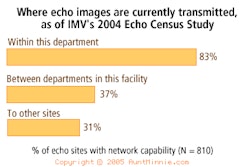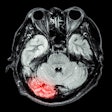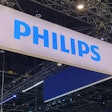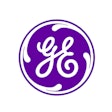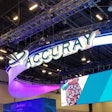CHICAGO - Healthcare imaging and IT vendor Eastman Kodak Health Group introduced a collection of new product offerings at the 2005 RSNA conference this week.
DR
The Rochester, NY-based firm unveiled its DR 3000, a new multipurpose digital radiography (DR) platform, as a work-in-progress system. The DR 3000 features a motorized, floor-mounted U-arm design with a moveable table that is capable of performing a variety of general radiography exams, including those with cross-table positions. The device utilizes the same cesium iodide flat panel detector technology available in other Kodak DR applications in 17 x 17-inch imaging area format, according to Steven Romocki, manager of clinical development for digital radiography.
A single integrated operator console controls all imaging and generator functions. The DR 3000 application software features Kodak image processing software and the same touch-screen operator interface as the vendor's other CR and DR systems.
The product, which is currently available in China, will be shipping worldwide in the second quarter next year at a price point of approximately $200,000, according to Kodak.
CR
The company demonstrated a portable long-length imaging accessory that provides digital images of erect and supine exams in conjunction with its CR systems. The Kodak DirectView CR Long-Length Portable Imaging System is designed for use in hospital x-ray rooms, surgical suites, orthopedic clinics, and can also be used for bedside portable exams.
When used with the DirectView CR 825, CR 850, CR 950, and CR 975 systems, the CR Long-Length Portable Imaging System captures full-spine or lower-extremity exams with an image size of 14 x 33 inches. The grid is integrated into a caddy with wheels for portability that supports use from one room to another, the company said.
Once the cassette has been exposed, a DirectView reader scans the plate and uses a proprietary software-based stitching algorithm to render a single image, without the need for manual intervention by technologists or radiologists, according to Kodak.
The cassette is available now.
On the digital mammography front, the firm demonstrated its DirectView CR Mammography feature for CR 850, CR 950, and CR 975 systems. This application offers the capability to produce mammography images using dedicated Kodak DirectView CR Mammography cassettes with new EHR-M screens. It is currently available in Europe, Asia, and Latin America, and in process for approval in the U.S. and Canada.
The cassettes, which feature a thicker layer of storage phosphor, are able to achieve a high spatial resolution and detective quantum efficiency (DQE), as well as a 50-micron resolution, according to Helen Titus, worldwide product marketing manager for computer radiography digital capture systems. The optional feature enables healthcare facilities to perform general radiography and mammography exams on the same CR platform, the company said.
Kodak highlighted the latest iteration of its CR application software, version 4.5, released earlier this month. The new version features a low-exposure optimization image processing capability and a clutch of marker additions, including free-text annotation as well as time and degree markers in varying increments.
The firm spotlighted its work-in-progress Point-of-Care CR 300M System for Mammography, a compact, dedicated tabletop CR system for mammography applications. Kodak said that its small form factor and economical price point will make it attractive for in-room applications at clinics, mammography imaging centers, or specialty areas within a hospital.
IT
Kodak showed off its CareStream line of imaging and information management systems. CareStream encompasses Radiology Solutions and Information Management Solutions, said Mike Fiske, marketing manager of healthcare information solutions, Americas. Radiology Solutions includes CareStream PACS and CareStream RIS.
Kodak also debuted an entry-level Windows-based PACS that bundles a PACS workstation with a storage server and the vendor's CR systems. Targeted at imaging centers, clinics, or smaller hospitals, the package is scalable and can be upgraded to a more fully featured PACS, according to the vendor.
The firm also showed version 10 of CareStream PACS as a work-in-progress. The new release will feature role-based, user-centric architecture that will support individual preferences, Fiske said. Users can utilize their preferred display protocols, menus, and tools, from any location inside or outside the institution, he said. Institutions will be able to utilize floating licenses.
Other features include automated installation and software updates via the Internet, as well as enhancements to Kodak's native real-time 3D capabilities, such as more interactive MPR functionality, more detailed reporting from automated vessel analysis, and minimum intensity projection, according to the vendor. CareStream PACS will also receive new cardiac CT functions, such as calcium scoring, automated heart axis detection and rib cage removal, and coronary analysis tools and reporting.
In addition, Kodak will incorporate the ability to integrate 3D key images, 3D analysis reports, and the radiology report into a single electronic report for distribution to clinicians and referring physicians.
Kodak is also showcasing new RIS features, including scheduling enhancements such as color-coded visual indicators of patient status to address patient wait times, single-click generation of normal reports, and workload indicators for single-click access to studies in different stages of completion.
Users can also interrupt and then resume report dictation, and perform remote diagnostic dictation and report signing through a Web module, Kodak said.
Kodak is also emphasizing its VIParchive-driven Information Management Solutions portfolio, which includes its Enterprise Information Management (EIM), Hosted Information Management (HIM), and Regional Information Management (RIM) services. EIM allows healthcare organizations to consolidate storage and manage clinical and nonclinical information across multiple sites and vendor platforms, while HIM includes data protection and remote archiving options, Fiske said. RIM is designed to extend clinical information life cycle manage to an entire geographic region.
Kodak also showed a clinical data repository viewer for VIParchive, scheduled for release in the second quarter of 2006.
CAD
Kodak showcased enhanced flexibility for its film-based mammography computer-aided detection (CAD) system, and announced that it is also developing digital CAD algorithms (currently works-in-progress) for full-field digital mammography (FFDM) and CR systems for mammography.
The latest version of the developer's film-screen CAD application features new options for viewing CAD results in portrait or landscape mode, which allows radiologists to configure the system to specific hanging protocol preferences. Also included is the capability to save scanned mammograms as DICOM files, allowing the digitized images to be sent to an archive or another PACS. In addition, the CAD product also has the ability to save log files from the system and report the number of markers per film and per case.
Kodak demonstrated a works-in-progress solution that will enable its mammography CAD hardware to also run bone mineral density tests. Using the same film and x-ray unit as a mammogram, an x-ray of a patient's hand is produced and scanned by the CAD digitizer.
The software automatically analyzes the hand image to produce a report that will indicate the patient's bone density. The ability to perform both types of exams on the same equipment and film will offer enhanced productivity for healthcare facilities and a more comprehensive exam for patients, Kodak said.
Imagers
In printing developments, Kodak is highlighting new features for its imagers. DryView 8900 now features a 25% faster time to first print, down from 95 seconds to 70 seconds, said Kurt Seestrom, segment portfolio manager of digital output systems.
DryView 8900 can also now print up to 225 films per hour, and is now 6 inches smaller, Seestrom said. It supports five film sizes and produces every image at 650 dpi resolution, according to the firm.
The 8150, an updated version of Kodak's 8100 imager, can print up to 70 films per hour and includes one film drawer. Users can select from 14 x 17-, 11 x 14-, and 14 x 14-inch film sizes, Seestrom said.
Kodak has also added a DICOM version of its CMI 1000 color printer.
In other introductions, Kodak is showing Medical Image Central software as a work-in-progress. The software serves as an image composition tool, allowing users to assemble images into a desired format for display and printing, said Daniel Bartlett, director of digital output.
The images can then be printed on film or paper, stored on a CD/DVD, or displayed on a monitor, he said. An image viewer is automatically written to each CD/DVD.
The software will be available as a free downloadable version, a paid version that includes connectivity to HIS/RIS/PACS networks, and a third version that can burn to CD or DVDs, Bartlett said. Medical Image Central is expected to be available in mid-2006.
By Jonathan S. Batchelor and Erik L. Ridley
AuntMinnie.com staff writer
November 30, 2005
Copyright © 2005 AuntMinnie.com





